#1895 Ephemera
Explore tagged Tumblr posts
Text
1895
GENTLEWOMAN
Coburg, December 7
The Dowager Duchess of Coburg celebrated her birthday yesterday, when she completed her seventy-fifth years. (...)
The little Princess Elizabeth of Hesse is a great delight to her grandmother and youthful aunts. Her Grand Ducal Highness is a decidedly pretty baby, with a fair, clear complexion, blue eyes and a good deal of pretty hair for her infant years.
source: britishnewspaperarchive.co.uk

6 notes
·
View notes
Text

Richelieu's head photographed 253 after his death in 1895, Church of the Sorbonne University in Paris
French vintage postcard
#postkaart#photo#vintage#postkarte#postal#death#postcard#richelieu#head#photography#1895#church#briefkaart#tarjeta#photographed#church of the sorbonne university#carte postale#ansichtskarte#paris#sorbonne#french#historic#sepia#university#ephemera
41 notes
·
View notes
Text





#1800s#1895#massachusetts#vintage ephemera#vintage advertisement#vintage photo#vintage photography#vintage book#roxbury#roxbury mass#boston massachusetts#boston ma#Jamaica plain#Massachusetts history#washington st#dudley st#h s lawrence clothing#us history#us
1 note
·
View note
Text
Did just a little bookbinding project this weekend. A few days ago, I came across this prayerbook from 1895 by Lilian Montagu, an important figure in turn of the century Reform Judaism. It's a fascinating primary source and piece of ephemera - written for the needs of busy, young working-class Jewish women, with prayers for things they would expect to deal with such as going into service, having to work on the Sabbath, and getting engaged. The final prayer is for facing antisemitic persecution.
I really love trying to match historic typesets. I retyped this largely in Century Schoolbook, with the numbers in the publishing date and table of contents in Bembo Std in order to get them oldstyle, not on the baseline. (The back copy is also in Bembo Std. I don't know how I obliterated the Renegade Bindery logo.) The blackletter font in 2001 Rotunda Formata, which was the closest match to the original I could find, although it's still unsatisfyingly different in a few ways. And one little ornament on the cover from Sughayer Separates, a very very useful group of fonts for historical typesets.
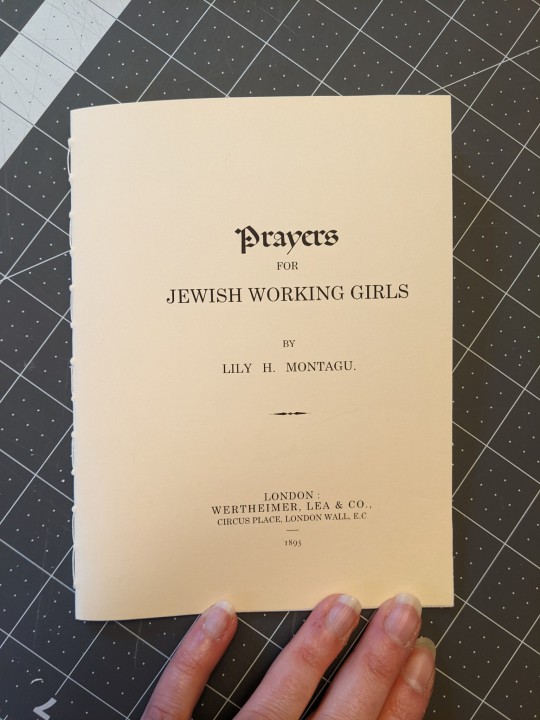


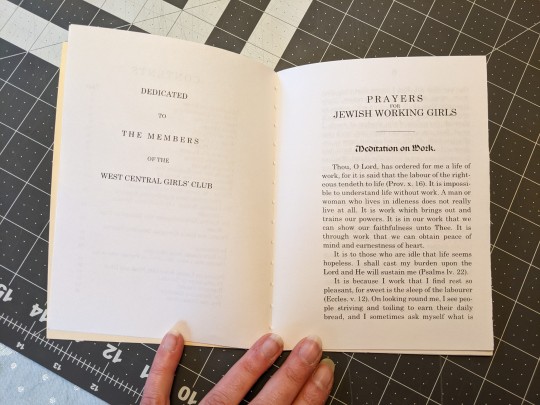
Unfortunately I'm just noticing now that I messed up the cover! Forgot about the border and the "Price Twopence." But in general, I think this looks quite a lot like the original - a credible piece of late Victorian ephemera.
Because the original is in a nonstandard page size - very tall and thin - I decided to make this version out of a nonstandard page size. I used some paper I'd had cut down to "executive" size a while back ... although I'd forgotten that my printer gets stupid with smaller page sizes, and messes up the margins. Annoying.
113 notes
·
View notes
Photo
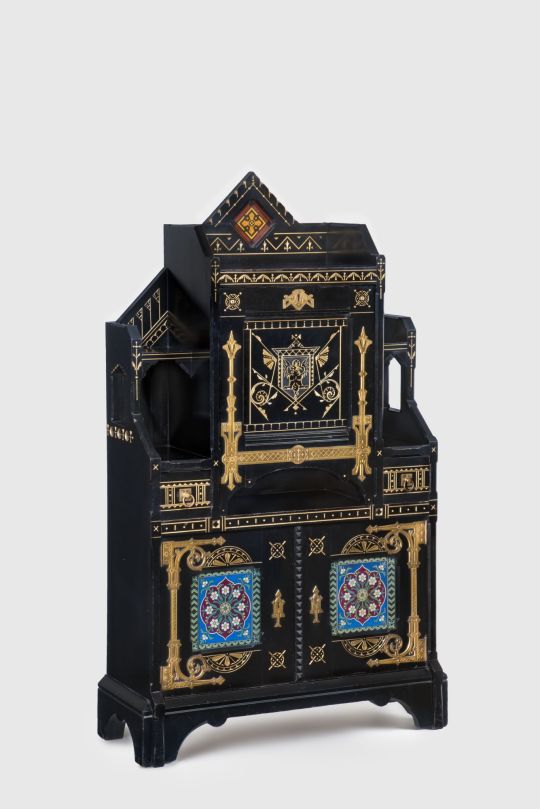
We're excited to share news about our upcoming exhibition Modern Gothic: The Inventive Furniture of Kimbel and Cabus, 1863–82. Over the course of their partnership, Anton Kimbel (1822–1895) and Joseph Cabus (1824–1898) developed one of New York City's leading furniture and decorating firms and defined a new take on Modern Gothic design, a style that originated in Britain and was embraced by a growing middle class in the post–Civil War United States.
Opening July 2, Modern Gothic is the first museum exhibition to trace the duo's American success story with new scholarship and primary sources, offering fresh insight into the history of the enterprising design team, their ambitious marketing practices, and their forward-looking clientele. The exhibition includes rare examples of furniture from their famous chair designs and dramatic, monumental desks to their quirky, smaller forms decorated with fanciful paper panels, as well as books and ephemera.
Kimbel and Cabus (New York, 1863–82). Cabinet-Secretary, circa 1875. Painted cherry, gilding, copper, brass, leather, earthenware. Brooklyn Museum; Bequest of DeLancey Thorn Grant in memory of her mother, Louise Floyd-Jones Thorn, by exchange, 1991.126. (Photo: Gavin Ashworth)
#brooklyn museum#anton kimbel#joseph cabus#design#bkmdecarts#bkmdesign#decorative arts#furniture#modern gothic#brooklyn#art#exhibition#design exhibition
98 notes
·
View notes
Text

Recent Acquisition - Ephemera Collection
First National Bank of Lexington, Virginia. Established in 1895. Bank Building Erected in 1902. ... Statement of Condition, November 1910
16 notes
·
View notes
Photo










Friends and rivals in so many ways, here’s a selection of ephemera related to the connections between Yale and Princeton.
1. Yale-Princeton polo program, June 18, 1892. Scrapbook Collection (AC026), Box 194.
2. Cover of the menu for the Yale-Princeton Banquet, December 6, 1895. This supper was given at the Princeton Inn immediately following the Yale-Princeton debate. At the meal, diners toasted Yale, Princeton, collegiate literary work, and intercollegiate contests. Historical Subject Files (AC109), Box 343, Folder 3.
3. Princeton-Yale baseball program, June 7, 1913. Princeton University Athletic Programs Collection (AC042), Box 14, Folder 1.
4. Yale-Princeton musical clubs concert program, November 14, 1924. Historical Subject Files (AC109), Box 193, Folder 11.
5. Ticket to the Yale-Princeton football game, November 12, 1932. Historical Subject Files (AC109), Box 143, Folder 4,
6. Princeton-Yale hockey program, February 20, 1965. 1971. Athletic Programs Collection (AC042), Box 15.
7. Princeton-Yale football program, November 13, 1971. Athletic Programs Collection (AC042), Box 8, Folder 5.
8. Jaws-style “PAWS” cartoon from the Daily Princetonian, September 9, 1975.
9. Princeton and Yale’s mascots together, November 1979. Photo from 1980 Bric-a-Brac.
10. Tiger mobile drawing (see the real thing pictured here) with the Yale bulldog in its stomach, 1996. Historical Photograph Collection, Campus Life Series (AC112), Box MP169, Image No. 6064.
#Princeton#Yale#sports#althetics#debate#football#polo#banquet#baseball#music#concert#hockey#cartoon#mascot#tiger#bulldog#art#Princetonarts#Princetonsports#PrincetonU#Princeton University
47 notes
·
View notes
Photo

Today’s #TradeCardTuesday brings us this ca. 1880? advertisement for Dobbins' Electric Soap, manufactured by Philadelphia’s Isaiah L. Cragin & Company (est’d 1867).
The brand’s name was bestowed upon it by its original manufacturer, John B. Dobbins, a Philadelphia soapmaker who presumably appended the ‘Electric’ to his product to capitalize on popular enthusiasm for the promise of electrification. Dobbins was also the manufacturer of Dobbins Medicated Toilet Soap and Dobbins Electric Boot Polish.
Dobbins appears to have temporarily lost the rights to the soaps that bore his name in 1869, along with use of his trademarks, manufactory, and the materials within it for a period of twenty years as a result of debts owed to Charles I. Cragin, the son of Isiah L. Cragin. This agreement would later result in a vicious court case. In 1890, rather than relinquish the use of the name as their legal agreement required, the Cragin family continued to make use of Dobbins’ brands and trademarks, and even incorporated in New Jersey as the Dobbins Electric Soap Manufacturing Company. Dobbins, described by J. Warren Coulston, the lawyer who drafted the original agreement as “very old” and “very poor”, chose to pursue the matter.
Ultimately, the New Jersey courts were unimpressed with the Cragins’ argument that the contract’s statement that “they may use his name upon and as descriptive of any soap or blacking they may hereafter make . . .” nullified term limits outlined elsewhere and gave them perpetual rights to the name and trademarks. John B. Dobbins won the case and was awarded nearly one million dollars in royalties that had been denied to him.
It’s not clear from newspaper accounts whether Dobbins was able to collect those funds, however. By 1895, his soap works at the corner of Susquehanna and Germantown Avenues in Philadelphia were in use by the Quaker City Chocolate Works, later known as the Quaker City Camden Company. Dobbins died not long after, on May 17, 1898 in Camden, New Jersey at the age of 68. The site of his soap works is now a vacant lot. The Cragins, meanwhile, retained operations of the Dobbins Soap Manufacturing Company and continued to use the brand name in advertisements denouncing similarly named products as “mediocre” imitators whose products would “rot and ruin clothes”.
Isiah, the elder Cragin, died on October 2, 1901. Charles I. Cragin, by then a wealthy man, who had also inherited his wealthy father’s estate, appears to have spent the rest of his life as president of the company and employed as a director of Philadelphia’s Fourth Street National Bank, though his December 16, 1915 obituary in the city’s Evening Public Ledger noted that he “devoted little time to either enterprise in the last 20 years���, preferring instead to entertain guests in his home in Philadelphia and in Reve D’Ete, his lavish vacation home in Palm Beach, Florida often described in the society pages as “the most luxurious of semi-tropical palaces” and which, in 1891, was touted as the “furthermost south mansion in the United States”.
The Dobbins Soap Manufacturing Company, located at 17th Street and Federal Street, remained in the hands of the Cragin family until 1934, when it was purchased by the Iowa Soap Company. By 1959, the Concord Chemical Company called the manufactory home, remaining there until the late 2000s, when the Concord Chemical Company manufactory became the abandoned Concord Chemical Site. Following intervention from the U.S. Environmental Protection Agency in 2010, the site was burned to the ground in a fire on June 19, 2011. In 2018, the former president and CEO of the by then defunct Concord Chemical Co. was sentenced to six months of home confinement for illegally storing and abandoning hazardous, corrosive, and ignitable waste at the facility.
This trade card is part of Hagley Library’s Carter Litchfield collection on the history of fatty materials (Accession 2007.227). As an organic chemist, Carter Litchfield (1932-2007) studied and specialized in edible fats. Over the course of his career, Litchfield built an important collection about the history of fats and fatty materials. This collection has not been digitized in its entirety. The online collection is a curated selection of items and primarily includes paper ephemera such as ration stamps, tax stamps, trade cards, pamphlets, and trade catalogs. You can view it online now by clicking here.
#TradeCardTuesday#trade card tuesday#trade card#advertising#vintage advertising#trade cards#Dobbins Electric Soap#John B. Dobbins#Charles I Cragin#Isiah L Cragin#Isiah L Cragin & Co.#soap fight#Dobbins v Cragin#1890s#1880s#Philadelphia history#Camden history#Camden NJ#Dobbins Soap Manufacturing Company#Reve D"Ete#Florida#Iowa Soap Company#Concord Chemical Company#Concord Chemical Site#Environmental Protection Agency#corporate history#Carter Litchfield#Carter Litchfield Collection#fatty materials#soap
58 notes
·
View notes
Photo
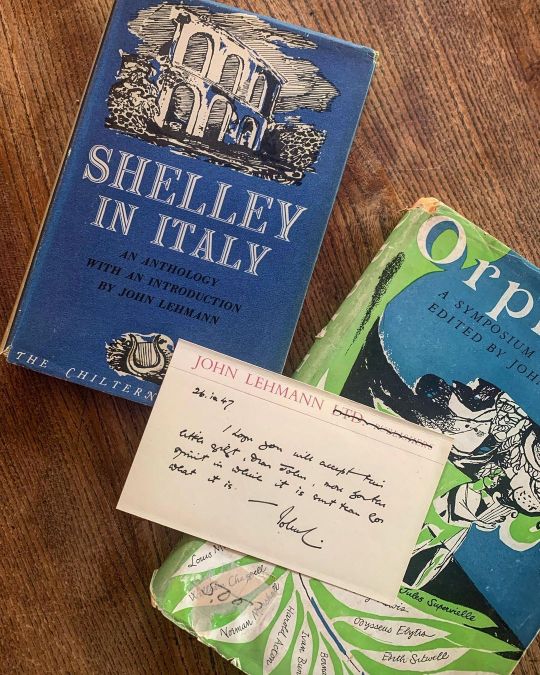
A happy find: one of today’s tasks has been wrapping vintage dust jackets in acetate to protect them. In this book ‘Shelley in Italy’ designed by Keith Vaughan I was delighted to find a postcard from the author and publisher John Lehmann himself inscribed ‘I hope you will accept this little gift, dear John, more for the spirit in which it is sent than for what it is - John L’. The book itself is dedicated ‘John Morris with affectionate wishes John Lehmann.’ Morris (1895-1980) was a literary figure, who worked at the BBC in the 1940s and 50s. He took part in two attempts to climb Everest in the 1930s (once with Tenzing Norgay as his Sherpa) and in his frank autobiography ‘Hired to Kill’ wrote about coming to terms with his homosexuality whilst in the army. He was Professor of English Literature, Keio University and lecturer at Imperial and Bunrika Universities, Tokyo from 1938. He became head of the BBC Far Eastern Service 1943–1952, and controller for the BBC Third Programme 1952–1958. From February 1943 to October 1943 he worked in the same department as George Orwell, at 200 Oxford Street. Stephen Spender described Morris in his Journals as: “A not very daring promoter of the cause of culture, cruelly teased by his friend E.M. Forster, who referred to him as 'the pudding'.” He was made a Commander of the Order of the British Empire in the 1957 New Year Honours, and appeared as a castaway on the BBC Radio programme Desert Island Discs on 16 February 1959 (Favourite track: Sonata in B Flat Minor (Opus 35) by Frédéric Chopin played by Rachmaninov, Book: The Brothers Karamazov by Fyodor Dostoyevsky, Luxury: Soap and a piano). It joins the dots with Lehman’s Ex Libris bookplate (designed by Vaughan) which I posted on here a couple of weeks ago, and recent thinking about @nancy_cadogan_art and her show in the @keats_shelley_house_rome . I get so excited by these bits of bibliophile ephemera and marginalia as they connect me directly to the authors, artists, publishers and readers, and their friends and loved ones. #bibliophile #bibliophilelife #book #modernbride #keithvaughan #johnlehmann #design #ephemera #bookjacket #queerart #gayart #lgbtqhistory (at Brighton and Hove) https://www.instagram.com/p/CKHMpAEFEki/?igshid=i9oubmiljdj1
#bibliophile#bibliophilelife#book#modernbride#keithvaughan#johnlehmann#design#ephemera#bookjacket#queerart#gayart#lgbtqhistory
2 notes
·
View notes
Photo
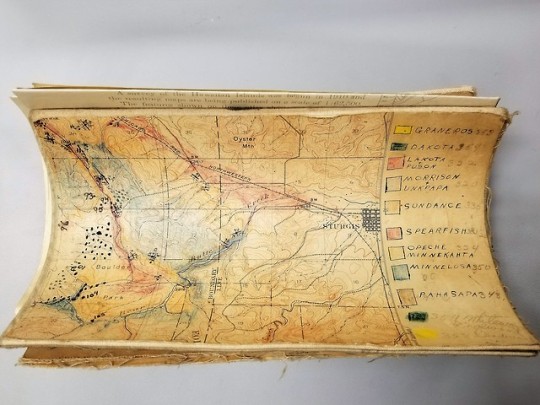
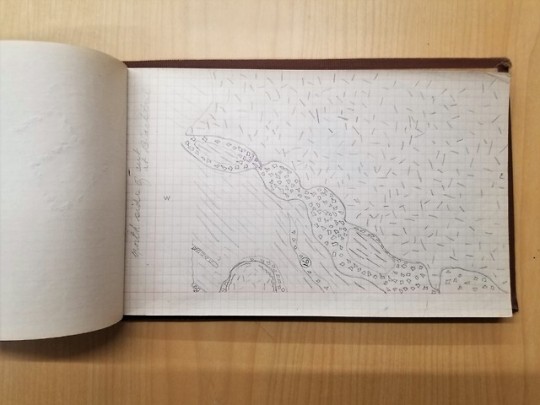


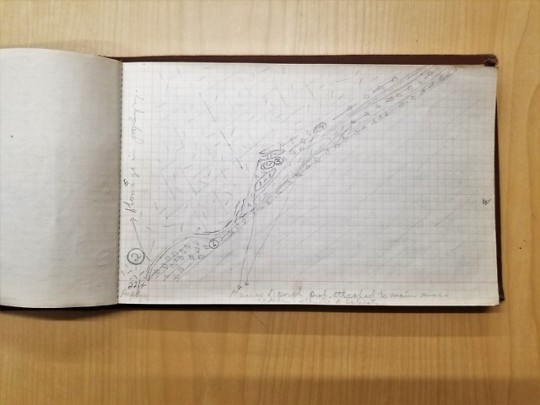


#VoicesFromTheStacks
Janet Kimpston, an Iowan hailing from the city of Elkader, was born in 1895. In her mid-20s, she attended the State University of Iowa (now the University of Iowa) from 1919 to 1921.
Her papers provide a brief glimpse into student life--particularly for young women--at the university in this era. While pursuing her English degree, Kimpston's courses ranged across academic disciplines, including Latin, literary courses on Whitman and Shakespeare, and a home economics course on sewing. Enrolling in geology courses, Kimpston was one of several female students who participated in field courses in 1920 and 1921 in the Midwest and the Black Hills of South Dakota. During field work in the Black Hills in 1920, Janet met Nathaniel Herz, her future husband; the couple would reside in South Dakota after marrying.
Situated in our stacks in the University Archives’ Student Life record group, this collection features ephemera from student life--class notes, projects, and materials from her typography field work. From a scrapbook containing sewing samples and necessary knowhow for darning lace, to book reviews, Latin transcriptions, and geological mapping, Kimpston’s collections speaks of a driven student and adventurer.
Janet Kimpston Herz Papers (RG02.0009.012)
Finding Aid
--Laura
#voices from the stacks#university of iowa#1920s#Geology#student life#vintage student life#women's history#women's student life#women in STEM#Black Hills#field work#adventure#maps#special collections
20 notes
·
View notes
Text
1895
Kölnische Zeitung
March 27, 1895

Darmstadt, March 20th. The Hessian princess born on March 11th, the first child of our Grand Duke and his wife Victoria Melita, received her baptism yesterday. She was given the names Elisabeth Marie Alice Victoria after her four godmothers: Grand Duchess Serge of Russia, Crown Princess Marie of Rumania, Empress Alexandra of Russia and Queen Victoria of England. Only one of them was present at the baptism; the grandfather, the Duke of Coburg and Gotha, was entrusted with the representation. The baptism was carried out by the high preacher Dr. Bender with water from the Jordan. A very numerous group attended the family dinner in the New Palace, during which a large group of residents gathered in front the palace to encourage the participation of the ¿vole?.
The general hope is that Princess Elisabeth of Hesse gains a reputation of virtue and beauty, as it happened with her numerous predecessors. Landgravine Karoline of Hesse with her four daughters was called "Great" and a beautiful monument sent by King Friedrich the Great was placed in the Darmstadt Herrengarten with the inscription: Femina sexu, ingenio vir ("a woman by sex, a man by spirit").
source: Zeitungpostal NRW
10 notes
·
View notes
Text

Head of Chinese pirates, decapitated in 1895 near Móng Cái, northern Vietnam
French vintage postcard
#photo#ansichtskarte#1895#postal#postkaart#sepia#french#tarjeta#ephemera#photography#carte postale#vietnam#historic#pirates#near#decapitated#móng cái#chinese#briefkaart#northern#postcard#vintage#postkarte#head
7 notes
·
View notes
Photo


(via The Experiment that was PAN Magazine)
The antiquarian book business is a curious one. It is a business that requires curiosity, research and a willingness to follow the threads of obscurity. Often one find will lead me to another and so on. Discoveries made in such a fashion feel serendipitous; like chasing a trail of breadcrumbs to some hidden treasure. The other day while researching an early edition of Sybil with a William Morris cover design I came across a peculiar art magazine called PAN.
The journal PAN was published in Berlin between 1895 and 1900 and it is regarded as one of the most influential voices of Art Nouveau in Germany. Edited by Otto Julius Bierbaum and Julius Meier-Graefe, the magazine published illustrations by well-known as well as unknown international artists. It also featured full page graphic designs, typographic experiments, poems, vignettes and other ephemera.
#pan#victorian#victorian magazine#book magazines#pan magazine#blog posts#ebon et noir#art mag#art magazines#lost magazines#old#old books#old book#antiquarian book#rare book#rare books#bookish#books#bookseller#antiquarian book seller
13 notes
·
View notes
Text
Ten Things to Do in Chicago This Week
Don’t-miss picks for October 25 through October 31, 2018
1 Night of 1,000 Jack-o’-Lanterns
Seasonal:As the name would indicate, there are, in fact, more than 1,000 pumpkins on display at this family-friendly Halloween standby, each one a carefully carved work of art. In the jack-o’-lanterns’ spectral glow, the gardens take on a spooky and autumnal atmosphere best enjoyed with a hot cup of cocoa or cider (spiked, if you’re a grownup) in hand. Through 10/28. $13–$18. Chicago Botanic Garden. chicagobotanic.org
2 Elton John
Rock:In January, John told Anderson Cooper he would be retiring from touring, stating, “My priorities are now my children and my husband and my family.” It’s a blow to longtime fans, but John won’t make his final exit until he completes a three-year international tour. 10/26–27. $181–$1,392. United Center. ticketmaster.com
3 Jessica Sladek
Art:In this emerging photographer’s Wait-A-While series, a tradition of bucolic landscape imagery (think Ansel Adams) is turned on its head — or rather, its roots. Focusing tightly on dirt, holes, and generally what’s beneath the feet, Sladek has an eye for finding the overlooked beauty of everyday nature. FREE 10/26–12/29. Schneider Gallery. schneidergallerychicago.com
4 Chicago Home Movie Day
Film:Each year, locals dust off and trot out their best (i.e., most pedestrian and mildly amusing) works of amateur film — specifically, those that are actually on film, in a format like 16 mm, 8 mm, or Super 8. Watching someone else’s home movies might sound about as much fun as, well, watching someone else’s home movies, but don’t be surprised if you leave the auditorium misty-eyed: There’s something undeniably powerful about seeing people and places frozen in time. FREE 10/27 at 11 a.m. Chicago History Museum. chicagofilmarchives.org
5 Nine Inch Nails
Rock:Back with its ninth studio album, Bad Witch, after four years away, Trent Reznor’s morbid industrial-rock outfit hasn’t lost any of its creepy power. Gen-X goths and younger fans who’ve flocked to NIN’s music won’t want to miss this rare tour. 10/25–27. $101–$143. Aragon Ballroom. ticketmaster.com
6 Jonathan Richman
Rock:The Modern Lovers produced just one album before dissolving in 1974, and that self-titled work is considered by some critics to be the germ of punk rock. Richman, the band’s idiosyncratic frontman, has developed something of a cult following ever since, even as he turns his back on the aesthetic trappings of punk. Though Richman now favors an acoustic guitar and a tempo more suited to easy listening than a mosh pit, his songwriting remains as strangely compelling as ever. 10/27 at 9 p.m. $18–$28. Thalia Hall. eventbrite.com
7 Keep Moving: Designing Chicago’s Bicycle Culture
Design:The bicycle is a symbol of personal freedom: the open road, the fresh air, the solitary sense of movement and power. This exhibit celebrates design innovations of the humble bike, including ephemera from Chicago’s top manufacturers then and now, like Schwinn, founded here in 1895, as well as reflections on why the local cycling community is so alluring. FREE 10/27–3/3. Design Museum of Chicago. designchicago.org
8 Jeff Arcuri
Comedy:Earlier this year, the standup made his Late Show with Stephen Colbert debut, and now he’s returning to the city where he got his start. Before he headed to New York, the earnest, upbeat comic hosted and produced the Chicago-based showcase This Week’s Show and regularly appeared at Laugh Factory, Comedy Bar, and Zanies, where he’ll be headlining. 10/29–31. $25. Zanies. chicago.zanies.com
9 Ina Garten: The Barefoot Contessa
Food/Lecture:On this tour, the beloved and inescapable restaurateur, cookbook author, and television personality shares stories and recipes from throughout her gastronomic journey and gives a sneak peek at her new book, Cooking Like a Pro — autographed copies of which will be available at the theater. 10/30 at 7:30 p.m. $53–$73. Chicago Theatre. ticketmaster.com
10 Kreutzer Connection
Classical:The Chamber Music Society of Lincoln Center builds a program around Beethoven’s “Kreutzer,” a violin sonata, and Leoš Janáček’s “Kreutzer Sonata” for string quartet, then interposes a work by the actual Kreutzer, a famous violinist who never actually played the Beethoven piece dedicated to him. 10/30 at 7:30 p.m. $30–$70. Harris Theater. harristheaterchicago.org
Share
Edit Module
Other Arts & Culture stories
Edit Module Source: http://www.chicagomag.com/arts-culture/October-2018/Ten-Things-to-Do-in-Chicago-This-Week/
1 note
·
View note
Text
Carmina burana composer

In the seemingly tedious way, creating a continuous supply of energy, provokingĪ modern audience's emotions. (1895 - 1982) Carl Orff was a 20th-century German composer, best known for his cantata Carmina Burana (1937). Melodies material, heavy and strong rhythm, a large number of repeated phrases Major themes: fickleness of fortune and wealth, the ephemera nature of life, the joy of the return of Spring, and the pleasures and perils of drinking, gluttony, gambling and lust Carl Orff describes his Carmina Burana, one of the most powerful masterpieces of the 20th century, as a scenic cantata.Muchel Hofmann, young law student and Latin and Greek enthusiast, assisted Orff in the selection and organization of 24 of these poems into a libretto.Here the UC Davis Symphony Orchestra, the University Chorus a. Banner, by CSO Mead Composer-in-Residence Jessie Montgomery, is a vibrant rhapsody on The Star-Spangled Banner. This clue was last seen on LA Times Crossword JanuAnswers In case the clue doesn’t fit or there’s something wrong please contact us. Up until this point, Orff had only been known to the general public as a musical educationalist and specialist for ancient music and only achieved his. Based on 24 poems from the medieval collection Camina Burana Carl Orff's Carmina Burana is one of the most popular pieces of the classical music repertoire. On this page you will find the solution to Carmina Burana composer crossword clue.

0 notes
Text
Ephemera 30 — Have you always wanted a live monkey?
Ephemera 30 — Have you always wanted a live monkey?
I remember this episode. via Please enjoy this ping pong ball obstacle course. via Morrell E-Z Serve Liver Loaf (1940s) Via via “Any cereal helps a gal avoid ‘mid-morning letdown’… as long as it’s Post Grape-Nuts Flakes”, 1958 Hires’ Rootbeer (1895) via via

View On WordPress
0 notes